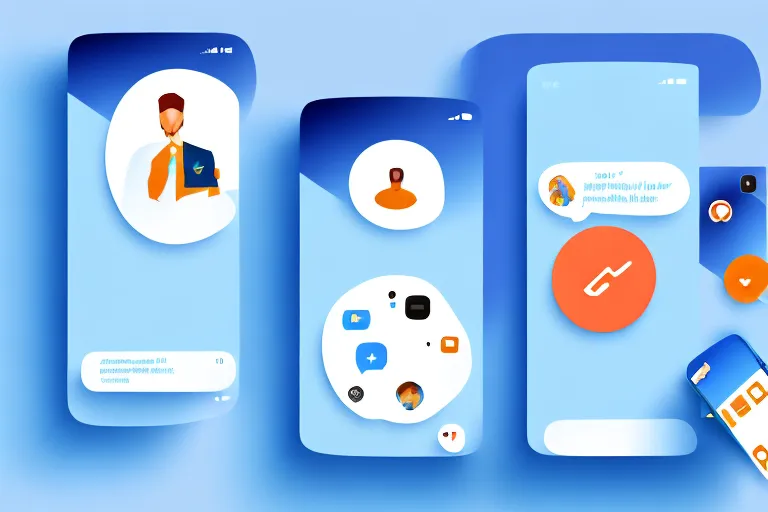Are you tired of the limitations of traditional SMS messaging? Have you heard about RCS messaging and want to know how to enable it on your device? In this article, we'll go over the basics of RCS messaging, the benefits it offers, the differences with SMS, the prerequisites for enabling it, and a step-by-step guide on how to enable it on both Android and iOS devices.
Understanding RCS Messaging
Before we go into the details of enabling RCS messaging, it's important to understand what it is and why it's gaining popularity. RCS (Rich Communication Services) messaging is a carrier-based messaging protocol that allows for advanced messaging capabilities beyond traditional SMS.
With RCS, users can send larger files such as images and videos, get read receipts, access to group messaging, and even make video calls over data. RCS also provides a better experience for businesses to interact with customers, with features such as chatbots and multimedia messages.
But what exactly makes RCS messaging so popular? For starters, RCS messaging is an evolution of traditional SMS messaging, providing an enhanced messaging experience with multimedia capabilities to Android devices. RCS aims to mimic the functionality of popular messaging apps such as WhatsApp and Facebook Messenger while using your cellular plan and not needing a separate account or application.
Another benefit of RCS messaging is that it takes advantage of data connectivity. With RCS messaging, you'll be able to send larger files, get read receipts, share your device's location, and even send multimedia messages. These features make RCS an attractive alternative to traditional SMS messaging for people who want more out of their messaging service.
One of the main differences between RCS and SMS is that RCS is a data-based protocol while SMS uses the traditional messaging infrastructure offered by mobile carriers. With RCS, you can send messages over data when available, meaning you can send and receive messages while on Wi-Fi without using your cellular minutes. Also, RCS supports read receipts and typing indicators that SMS does not offer.
What is RCS Messaging?
RCS Messaging is a messaging protocol that enables advanced messaging capabilities beyond traditional SMS. It provides an enhanced messaging experience with multimedia capabilities to Android devices. With RCS messaging, users can send larger files, get read receipts, access to group messaging, and even make video calls over data. RCS also provides a better experience for businesses to interact with customers, with features such as chatbots and multimedia messages.
Benefits of RCS Messaging
Unlike SMS messaging, RCS can take advantage of data connectivity. With RCS messaging, you'll be able to send larger files, get read receipts, share your device's location, and even send multimedia messages. These features make RCS an attractive alternative to traditional SMS messaging for people who want more out of their messaging service.
Differences between RCS and SMS
One of the main differences between RCS and SMS is that RCS is a data-based protocol while SMS uses the traditional messaging infrastructure offered by mobile carriers. With RCS, you can send messages over data when available, meaning you can send and receive messages while on Wi-Fi without using your cellular minutes. Also, RCS supports read receipts and typing indicators that SMS does not offer.
Overall, RCS messaging is a great option for those who want a more advanced messaging experience with multimedia capabilities. With RCS messaging, you can send larger files, get read receipts, access to group messaging, and even make video calls over data. RCS also provides a better experience for businesses to interact with customers, with features such as chatbots and multimedia messages. So, if you're looking for a more advanced messaging experience, consider enabling RCS messaging on your Android device.
Prerequisites for Enabling RCS Messaging
Rich Communication Services (RCS) messaging is an advanced messaging protocol that allows users to send and receive messages that include multimedia content, read receipts, and typing indicators. If you're interested in enabling RCS messaging, there are a few prerequisites that you need to meet.
Compatible Devices and Carriers
To enable RCS messaging, you must first determine if your device and carrier support this communication protocol. At the moment, RCS is supported on most modern Android devices and select iOS devices. However, it's important to note that not all carriers support RCS messaging, so you should check with your carrier to see if they offer this service.
If your carrier supports RCS messaging, you'll need to ensure that your device is compatible with the protocol. Some older devices may not support RCS messaging, so you should check your device's specifications to make sure it's compatible.
Required Software Updates
If you have a compatible device and carrier and haven't updated your messaging application, you need to make sure that you have the latest version of the messaging application. This is important because the messaging app versions that carriers provide could be different.
Updating your messaging application is usually a simple process. You can check for updates in the app store on your device or follow your device manufacturer's instructions to update the messaging application to the latest version.
Internet Connection
RCS messaging requires an Internet connection to function properly. If you're trying to enable RCS messaging with a mobile network, make sure that you have a reliable and stable data connection. This will ensure that your messages are sent and received quickly and without any issues.
Alternatively, if you're using Wi-Fi, ensure that your signal is strong enough to support RCS messaging. A weak Wi-Fi signal could cause your messages to be delayed or not sent at all.
It's also important to note that some carriers may charge for data usage when using RCS messaging. You should check with your carrier to see if there are any additional charges for using this service.
By meeting these prerequisites, you'll be able to enjoy the benefits of RCS messaging, including the ability to send and receive messages with multimedia content, read receipts, and typing indicators.
Enabling RCS Messaging on Android
Rich Communication Services (RCS) messaging is a new and improved way to send text messages on Android devices. RCS messaging allows for better group messaging, read receipts, and typing indicators. In this guide, we'll walk you through the steps to enable RCS messaging on your Android device.
Setting Up Google Messages
Google's Messages app is the most popular way to use RCS messaging. To enable RCS messaging on Android, you first need to make sure you have the latest version of the app. If you don't have it, download it from the Google Play Store. Once downloaded, open the Google Messages app on your Android device, and tap on the three dots located at the top right of the app.
Google Messages is a free messaging app that comes pre-installed on many Android devices. It's a great option for those looking to use RCS messaging, as it's easy to set up and use.
Activating RCS Features
Once the app is open, select "Settings" from the menu that appears, then tap on "Chat Features." From here, you can enable RCS messaging by toggling the switch located at the top of the screen. Once enabled, you'll notice a few new features, including read receipts and typing indicators.
Read receipts allow you to see when someone has read your message, while typing indicators let you know when someone is typing a response. These features can be incredibly useful for group messaging, as they allow for better communication and coordination.
Troubleshooting Common Issues
If you experience any issues enabling RCS messaging, the first thing to check is whether your carrier supports the service. In some cases, RCS messaging may not be available with your carrier. Alternatively, if you're having trouble sending and receiving messages, try restarting your device, clearing the cache of the messaging application, or turning off and on your mobile data network.
It's also important to note that RCS messaging is not available on all Android devices. If you're unsure whether your device supports RCS messaging, check with your device manufacturer or carrier.
Overall, RCS messaging is a great way to enhance your texting experience on Android. With its improved features and functionality, it's definitely worth enabling if you have the option.
Enabling RCS Messaging on iOS
Using a Third-Party App
Unlike Android devices, iOS devices do not have native support for RCS messaging. This means you'll have to use a third-party application to access the functionality. There are several great applications to choose from, including WhatsApp, Facebook Messenger, and Google Messages.
Setting Up the App for RCS Messaging
After you've downloaded a third-party messaging application, such as Google Messages, follow the app's setup instructions to enable RCS messaging. For example, in Google Messages, you'll need to go to the app's settings and enable the "Chat Features" option to use RCS messaging.
Limitations and Workarounds
One of the main limitations of using a third-party application for RCS messaging is that you'll need to convince your friends and family to use the same app as you. Alternatively, you can use the traditional messaging app for iOS if you don't mind missing out on the added functionality provided by RCS messaging.
Conclusion
RCS messaging is an exciting development that offers an enhanced messaging experience beyond traditional SMS messaging. Whether you're using an Android or iOS device, there are several ways to enable RCS messaging. By following the guidelines and instructions in this article, you'll be able to take advantage of the benefits offered by RCS messaging in no time!

